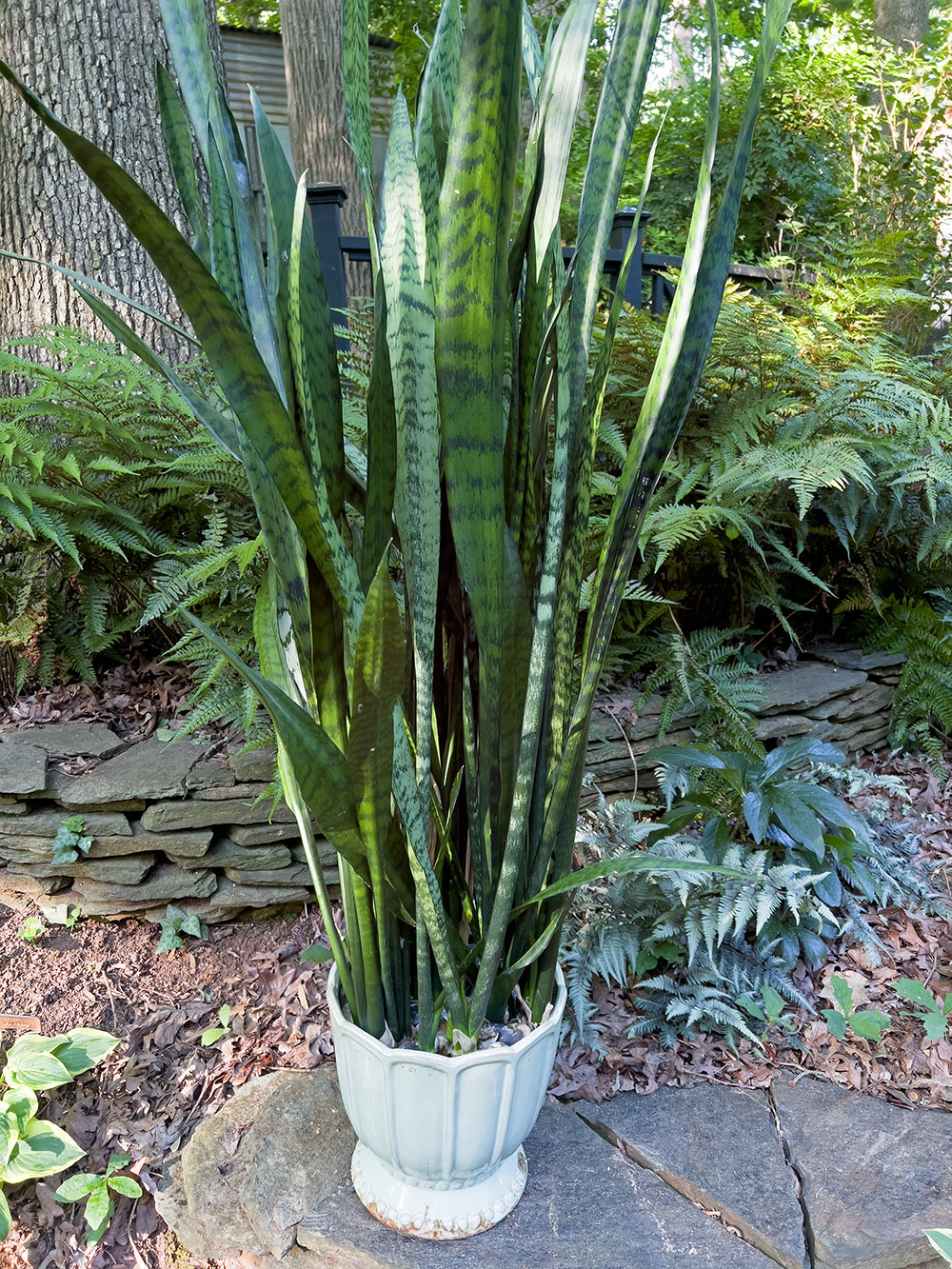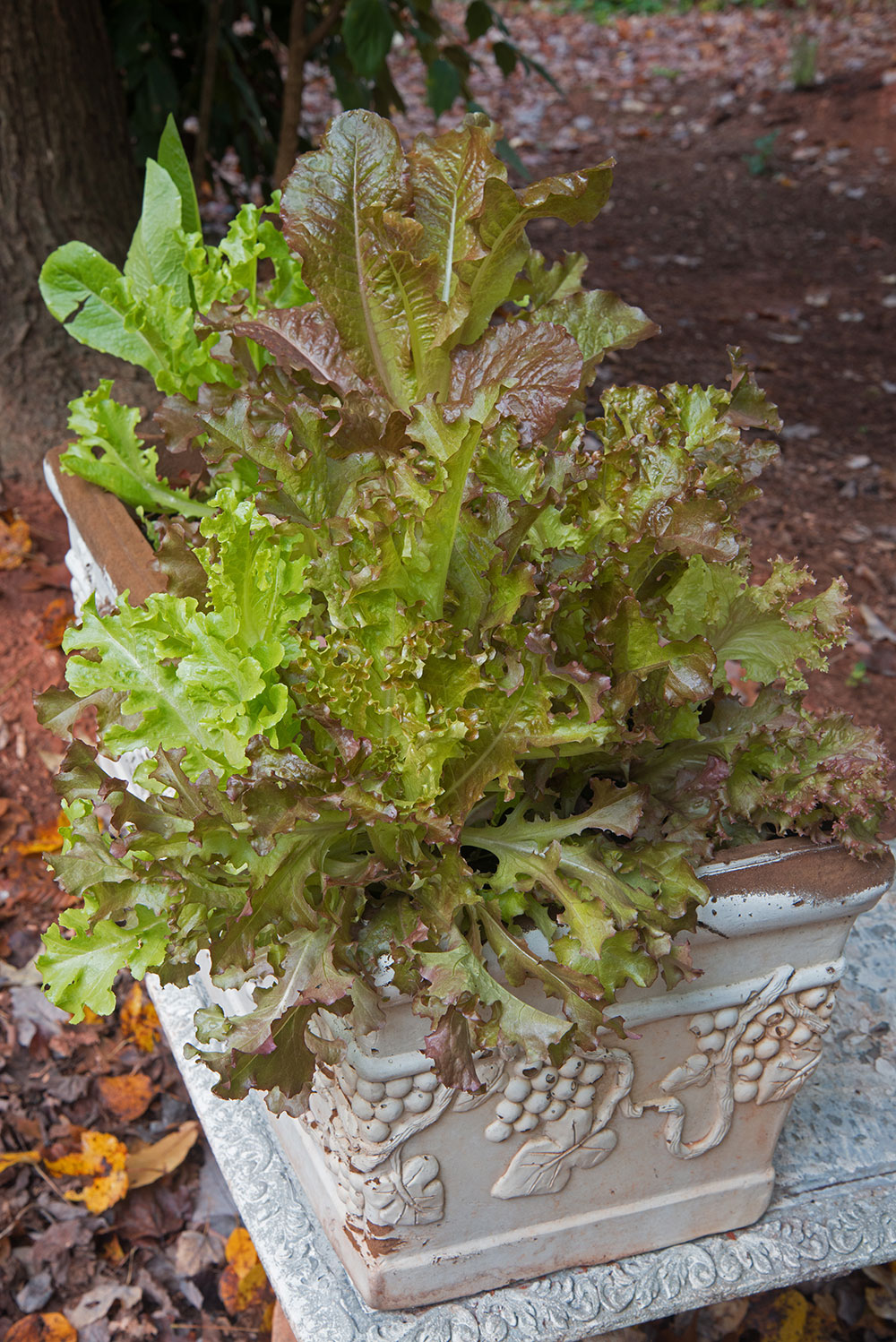Look up “July” in the dictionary, and the synonym “hot” will pop up — or, at least, it should. But even as summer reaches its full scorch, believe it or not, this month is a good time to start planting many cool-season vegetables.
One of my favorite hot-planted cool-season veggies to get crankin’ now is loose-leaf lettuce because it is easy to grow from either seeds or starter plants and matures quickly. It is also quite tasty and very nutritious. As a big bonus, many cultivars are good looking, too.

Check for pests on houseplants vacationing outdoors such as this snake plant
Have your houseplants been enjoying the great outdoors this summer? Well, they can continue to benefit from the balmy weather until they are brought back inside in the early fall before nighttime temps dip into the low 50s. But now is a good time to start policing for pests so they won’t cause problems this winter. Check closely for any activity from such bad bugs as aphids, spider mites, whiteflies, or mealy bugs, and use insecticidal soap spray to dispatch accordingly. Also, if you see any suspicious clusters of bumpy dots on leaves, they are probably insect eggs waiting to hatch, so scrape them off with a dull knife.
Although they take longer to fully mature, lettuce seeds have the advantage of being easy to find now. In addition, you will have more cultivar choices to pick from if you go with seeds rather than plants.
Lettuce seeds germinate better when kissed by the sun, so, in an open, well-worked, heavily amended spot in the veggie garden, scatter the seeds on the ground and then lightly press them into the soil. Keep the seeds evenly watered, and when plantlets sprout, thin them out to about 5 inches apart. If you want a steady supply of garden-grown crunchies deep into the autumn season, make additional plantings every two weeks until the middle to end of September.
The vegetable garden is an obvious place to grow loose-leaf lettuce, but, as I mentioned, it can be a rather attractive plant. So why not see how it shows off accenting autumn ornamental border plantings where you would typically place fancy foliage flashes such as coleus, polka dot plant, or dusty miller? Just remember to avoid using pesticides not designed for use on edibles when combining lettuce with any ornamentals.
And since loose-leaf lettuce likes good drainage, it also makes a no-brainer choice for adding extra interest to fall planters. For many years, I have been having fun turning these everyday edibles into potted pleasures. Even common varieties such as ‘Black Seeded Simpson’ and ‘Green Oak’ are pretty little things, so adding them to containers 6 inches in diameter or larger on decks, porches, or patios creates a feast for the eyes as well as the tummy.
Want even more visual zing? Try ‘Red Oak,’ a crimson-tinged doppelganger of ‘Green Oak.’ Even more frilly can be enjoyed with such dillies as ‘Red Sails’ and ‘Lollo Rossa’ — both easy-to-find cultivars that sport wavy foliage dipped in pleasing shades of deep red.
To Do in the Garden
July
- To help prevent the proliferation of diseases and insects that thrive on the spent remnants of roses, rake up and trash any fallen flowers and foliage every week or two. Do not compost.
- Brown patches of grass in the yard aren’t necessarily the result of summer drought. Push a shovel into the top few inches of an afflicted area and turn the soil over. If there are any short, white “worms” present, it means that lawn grubs have been gorging themselves on grass roots. For the best way to eradicate these little nasties, check with your local friendly garden center.
August
- Looking to add more visible snap-crackle-pop to your midsummer garden? Grab some sunscreen along with a big, floppy shade hat and check out local botanical gardens, arboretums, and even garden centers to see what kinds of plants show off best for them during these hazy, lazy days of August.
- Continue harvesting mature cucumbers, squash, green beans, indeterminate tomatoes, and okra plants at least once or twice a week to encourage maximum production from these summer veggies.
- Before the big leaf drop this autumn, prune off any dead, diseased, or damaged limbs on your woody ornamentals.
- Since they are in regular use now, check your garden hoses for loose connections or signs of leaking splits. Tighten, repair, or replace, if necessary, to help conserve community water this summer.
- Out & About in Wake County: July / August 2023
- Erica Chats: Embrace Summer
- Small Business Spotlight: TheMixx
- Hey There, Hot Stuff
- Worth the Drive: Rustic Roots
- Summer Recipes from the Garden
- Pay it Forward: Inter-Faith Food Shuttle
- Flavor at Your Fingertips: Viv’s Fridge
- Lechon Latin BBQ & Bar
- Celebrated Spirits: Roman Holiday
- Celebrated Spirits: La Surfeza
- Garden Adventurer: Fall for Loose-Leaf Lettuce








